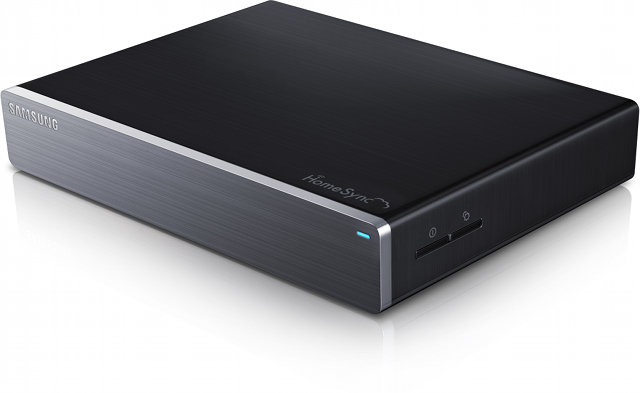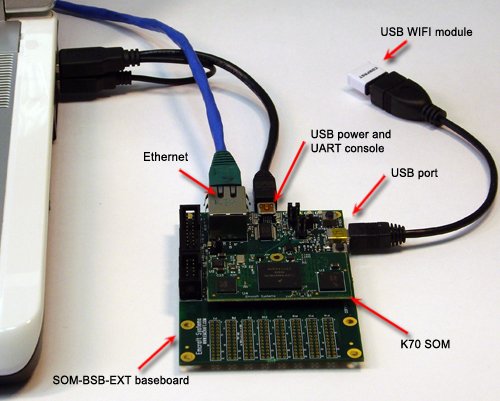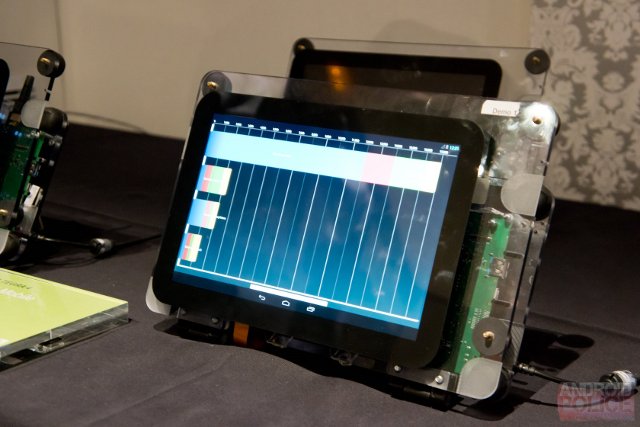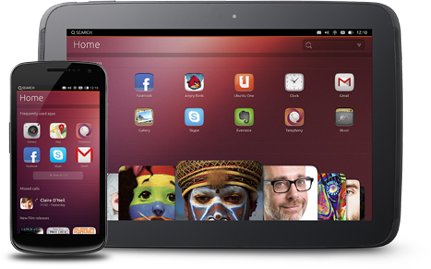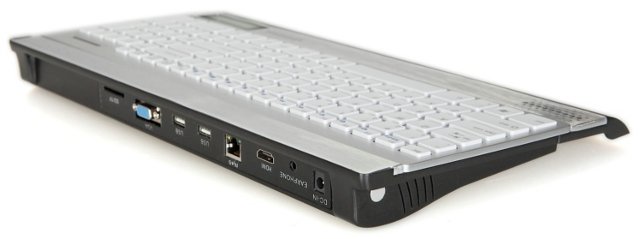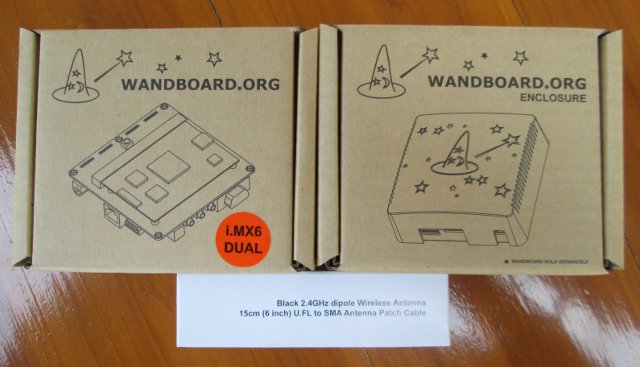Yesterday, Samsung announced the HomeSync, a media server featuring a dual core processor at 1.7 GHz, 1GB RAM, 8GB eMMC, and a 1TB hard drive. HomeSync is said to be running a modified version of Android Jelly Bean. Here are HomeSync specifications: Processor – Dual Core @ 1.7GHz (I’d guess it should be the Exynos 5250, but why all the mystery?) System Memory – 1GB DDR3 Storage – 8GB eMMC + 1TB HDD Connectivity LAN – Gigabit Ethernet WiFi – 802.11 b/g/n 2.4GHz & a/n 5GHz HT40 2×2 MIMO Channel Bonding Bluetooth – V4.0 USB – 2x USB 3.0 Host, 1x Micro USB (11pin) Video Output – HDMI out Audio – Optical Audio (Audio Amp. Connection) Video Codec – H.264, H.263, MPEG4, VC-1, Sorenson Spark, WMV7/8, MP43, VP8, DivX Audio Codec – MP3, AAC LC/AAC+/eAAC+, WMA 9std/10pro/Lossless, FLAC, Vorbis, AMR-NB/WB, Wav, Mid, AC-3 DRM – HDCP 1.3/2.1, Playready, Widevide, Trustzone […]
Adding Wi-Fi to Emcraft Systems K70 SoM
Emcraft Systems K70 SoM is a system-on-module powered by Freescale K70 Cortex M4 micro-controller with enough RAM (64 MB) to comfortably run uClinux. They used to charge $99 for their uCLinux BSP, but it’s now free of charge, and the company also provides full hardware and software documentation, including a getting started guide, schematics and BoM for the baseboard, application notes and more… Many of their clients want to use Wi-Fi with K70 SoM, and it can easily be done by using Wi-Fi USB dongles based on Ralink RT5370 chipset such as D-Link DWA-140 (H/W rev B3) or Comfast CF-WU815N. Emcraft has provided detailed instructions to do so with K70 SoM, their latest baseboard (SOM-BSB-EXT) and a demo image based on their uClinux BSP. I’ll summarize the instructions to use K70 SoM as a Wi-Fi access point below. Connect the baseboard and K70 SoM with an Ethernet cable, a mini […]
Nvidia Tegra 4 Benchmarks on Tablet Reference Design
Mobile World Congress 2013 has just started. Nvidia is showcasing both a smartphone reference platform based on Nvidia Tegra 4i (Phoenix reference phone) and an unnamed tablet reference design with Tegra 4 during the event, and several Android benchmarks have been run on the platform including Antutu and Quadrant. The results in the quad-core Cortex A15 Tegra 4 are really impressive with over 36,000 in AnTuTu and 16,000 in Quadrant, which are the best scores ever reported (by far) on those two benchmarks, as the top score in Antutu achieved with an overclocked Galaxy Note 2 is just over 27,000, a phone like the HTC One X scores around 5,600… Android Police also ran two other benchmarks that can help to access web browsing performance: Vellamo (HTML5) and SunSpider. The Tegra 4 completes SunSpider in 494ms (vs 1124ms with HTC One and 208ms in my desktop PC), and scores 3300 […]
ISEE Introduces IGEP COM CYGNUS & AQUILA Powered by TI Sitara AM335x Processor
ISEE will officially launch and showcase 2 new computers-on-module at Embedded World 2013 on February 26-28, in Nuremberg, Germany: IGEP COM CYGNUS and IGEP COM AQUILA. Both CoM shares the same characteristics except the former is powered by TI Sitara AM3352 (Cortex A8, no GPU) and the later by TI Sitara AM3354 (Cortex A8 + PowerVR GPU). This makes the CYGNUS suited for cost sensitive applications such as industrial control, home automation, and test and measurement devices, and the AQUILA for applications that requires more advanced graphics and multimedia capabilities such as gaming, auto infotainment and navigation devices. The key specifications of the 2 modules are as follows: Processor – Texas instruments Sitara AM3352 Cortex A8 @ 720 Mhz (CYGNUS) and AM3354 Cortex A8 @ 720 Mhz + PowerVR SGX GPU (AQUALIA) System memory – 256 MB DDR3 SDRAM, 303 MHz, 16-bit Storage – 128 MB SLC NAND FLASH + […]
Ubuntu Touch Developer Preview Is Now Available for the Galaxy Nexus and Nexus 4, 7 and 10 Devices
As promised with the announcement of Ubuntu on Tablets, Canonical released a developer preview of Ubuntu 12.10 for smartphones and tablets that can be installed in Galaxy Nexus and Nexus 4 smartphones, as well as Nexus 7 and Nexus 10 tablets. It is an experimental development snapshot that could potentially brick your device. Many features are still not available but you should be able to access the following: Shell and core applications Connection to the GSM network (on Galaxy Nexus and Nexus 4) Phone calls and SMS (on Galaxy Nexus and Nexus 4) Networking via Wifi Functional camera (front and back) Device accessible through the Android Developer Bridge tool (adb) You’ll be able to reinstall Android after trying it out, but all your data will be lost, unless you use apps such as Titanium Backup. The instructions to install Ubuntu 12.10 Touch are available on Canonical website, and you’ll basically […]
CoolShip is a $89 Rockchip RK3066 Android Keyboard Desktop Computer
If you’re nostalgic and miss your Commodore C64, FocusWill Coolship could be right for you. It’s a keyboard desktop computer running Android 4.0 ICS (or a customized of Android version called CoolShip OS) powered by Rockchip RK3066 SoC with 1GB RAM, 4 to 8 NAND Flash, VGA and HDMI outputs and more. Here are the specifications of this device: SoC – Rockchip RK3066 Dual Cortex A9 @ 1.5Ghz + Mali-400MP4 GPU System Memory – 1GB DDR3 RAM Storage – 4 to 8 GB NAND Flash + SD Card slot Connectivity: 10/100Mbps Ethernet (via USB to Ethernet chip) 802.11b/g/n Keyboard – 104 Standard QWERTY keyboard with number keys + Touchpad Video Outputs – VGA + HDMI with dual display support. Video Codecs – MPEG-1/2/4, H.264, H.263, RMVB, WMV, VC-1, AVS, MVC, RV8/RV9/RV10, VP6/VP8 Audio I/O – Stereo Speakers (2×1Ω;0.7W), 1x MIC and 1x Earphone jack USB – 2x USB2.0 Power Supply […]
Wandboard Dual Unboxing and Quick Start Guide
I’ve just received Wanboard Dual development board together with an enclosure, and Wi-Fi antenna. This board is powered by Freescale i.MX6 Duallite Cortex A9 processor, and comes with 1GB RAM, HDMI output and Ethernet. There’s also a version based on Freescale i.MX6 Solo with 512 MB RAM. You can refer to my earlier post for more detailed specifications. I’ll start by showing some unboxing pictures of the board, and write a quick start guide (casing assembly, Ubuntu & Android boot, and development). I also planned to run some benchmarks and test videos, as according to a poll on Wandboard website many people want to use it as a media player, but I’ll do that a bit later since the current Android image is not up to the task yet. Wandboard Dual Unboxing The package I received contained 3 boxes: one for Wandboard Dual board, one for the enclosure, and one for […]
Final Release of Fedora 18 for AllWinner A10 & A13 Powered Devices
A few months ago, Hans de Goede, currently working at Red Hat and a Fedora contributor, started to show up on linux-sunxi mailing list, and sent a lot of kernel patches for linux-sunxi kernel. Last week-end, he announced “Fedora 18 Final for Allwinner A10 and A13 based devices” on linux-sunxi community mailing list. To install it, first download the image:
|
1 |
wget http://scotland.proximity.on.ca/contrib-images/hansg/Fedora-18-a10-armhfp-r1.img.xz |
And write it to an SD card (all data will be wiped out):
|
1 |
xzcat Fedora-18-a10-armhfp-r1.img.xz > /dev/mmcblk0 |
You may have to replace “/dev/mmcblk0” by your own SD card device, e.g. “/dev/sdc”. AllWinner based devices can share the same kernel, but u-boot is board/products specific, so you’ll have to install u-boot for your board. First remove the SD card, re-insert it in order to automatically mount the FAT partition, and run:
|
1 |
sh <uboot-part-mount>/select-board.sh |
This will show the list of supported boards and products. Then run the command again for your device. For example:
|
1 |
sudo sh <uboot-part-mount>/select-board.sh mk802 |
[…]


